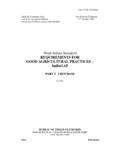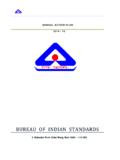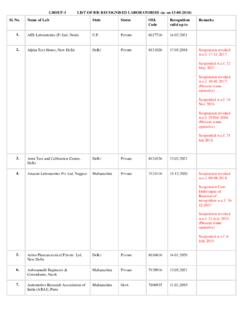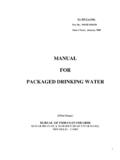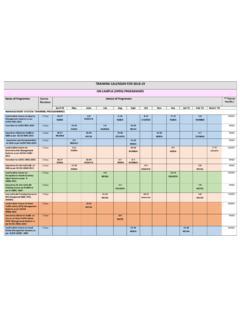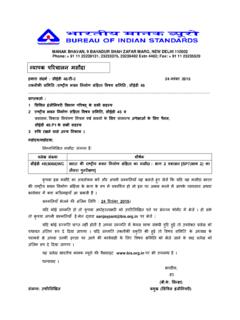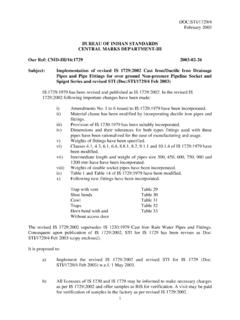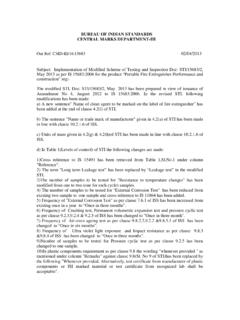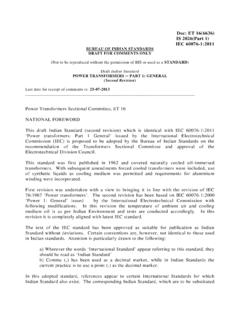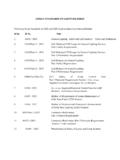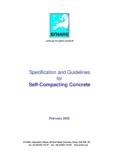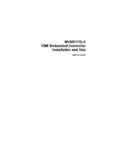Transcription of FOR BIS USE ONLY Doc No.: SM/IS14543 & …
1 1 FOR BIS USE ONLY Doc No.: SM/IS14543 & is13428 /03 manual FOR PACKAGED WATER (Third Issue) Date of Issue: March 2013 2 CONTENTS Item Chapter Page No 0 Foreword 3 1 Introduction 4 2 Scope 5 3 Product Description 5-8 4 Grant of Licence 8-14 5 Operation of Certification 14-19 6 Guidelines for Assessment of Hygienic Conditions with Explanatory Notes 19-35 7 Useful Tips for Inspecting Personnel & Guidelines for Reused Containers 35-37 ANNEXES 1 Check List For Scrutiny of Application 38-39 2 Report of Preliminary Inspection 40-45 3 Verification Report By BIS IO 46-47 3A Factory Testing Report 48 3B Samples for Independent Testing 49 4 Check List For Good Hygiene
2 (Applications) 50-54 5 Typical Manufacturing Process, Process Flow Chart,CIP Process 55-58 6 Check List for Red Form Processing 59-61 7 Report of Periodic Inspection 62-65 7A Assessment of Compliance to IS 13428/IS 14543 66-67 7B Details of Testing from OSL 68 8 Hygiene Check List (Licences) 69-70 9 List of Test Facilities A Organoleptic and Physical Requirements 71-73 B Chemical Requirements 74-98 C -Toxic Substances 99-105 D -Microbiological Requirements 106-113 E -Bottle / Container Requirements 114 F -PE Flexible Pouch Requirements 115-116 3 0.
3 FOREWORD BIS has published two Indian Standards on packaged water for drinking purpose, namely, IS 13428 for Packaged Natural Mineral Water (PNMW) and IS 14543 for Packaged Drinking Water (Other Than Packaged Natural Mineral Water) (PDW). Both the products were brought under mandatory BIS certification effective from 29 March 2001 through two gazette notifications issued by Ministry of Health and Family Welfare, namely GSR No. 759 for Packaged Natural Mineral Water (PNMW) and GSR No. 760 for Packaged Drinking Water (PDW) as amendments to Prevention of Food Adulteration Rules. Presently, these products under mandatory BIS certification are covered under FSSAI regulation.
4 In the early stages of certification of PDW, different situations were handled differently by ROs/BOs. This had necessitated issuance of several guidelines for creating uniformity in certification of PDW throughout the country. Further, a need was felt to compile all these guidelines into a manual . Thus, the manual for PDW was brought out in the year 2005. Revision of the manual has been taken up to suitably incorporate the changes that had taken place since 2005 in the certification of PDW and also in the general policies of product certification. A specific sub-section for guidelines related to PNMW such as for constancy of source water and criteria for decision seasonal variations etc introduced.
5 Packaged Drinking Water (Other Than Packaged Natural Mineral Water) (PDW) Packaged Natural Mineral Water (PNMW) are basically packaged water for drinking purpose. Therefore, title of this manual is manual FOR PACKAGED WATER . Salient changes in this version of the manual are as follows: updation of the manual with respect to various amendments to IS 14543 and IS 13428 and guidelines issued from time to time; incorporation of guidelines under simplified procedure for GOL and inclusion; updation of the list of test equipment as per revised test methods wherever applicable; inclusion of the list of test equipment for Bottles/Containers and PE Flexible Pouch for Packaged Water; and exclusion of the provision of verification by Chartered Engineer under the simplified scheme for grant of licence.
6 This manual is intended only for internal use by BIS officers and inspection personnel working on behalf of BIS. However, others can draw benefit from the manual to improve their activities related to certification of PDW and PNMW. Suggestions for any improvement in this manual may be sent to CMD 2. 4 1 INTRODUCTION The Standard IS 14543 provides sufficient freedom to the manufacturer to adopt any process for converting raw water into packaged water for drinking purposes. Therefore, the required manufacturing machinery for the purpose is neither specified in the respective Indian Standard nor in this manual . Illustrative examples have been given of typical manufacturing process with process flow diagram, cleaning and disinfection (CIP) of plant and machinery, pipelines as well as of containers in Annex 5.
7 However, there are restrictions with regard to processing of PNMW as specified in IS 13428, such as the source water shall not be subjected to process steps, such as reverse osmosis, demineralization or disinfection before packaging. IS 13428 and 14543 prescribe a large number of requirements to be tested as per the methods of tests given in the various cross-referred standards. Further, many requirements have options for selection of test method to be followed. This has made the task of the inspecting official difficult and time consuming for complete assessment of adequacy of the test facilities. This manual provides a ready reference for the inspecting official to check facilities for each of the requirements against the method given under the relevant Indian Standard and the method chosen by the firm (Annex 9).
8 All efforts have been made to incorporate details as per the latest versions of the standards. However, as the standards are dynamic and subject to amendments and revisions, users are encouraged to check the latest versions of the respective methods of test subsequent to issuance of this issue of the manual , before using the information contained herein. 5 2. SCOPE This manual of Packaged Water provides guidelines for various aspects related to certification of Packaged Natural Mineral Water and Packaged Drinking Water (Other Than Packaged Natural Mineral Water) according to IS 13428 and IS 14543 respectively along with the respective STIs.
9 The provisions of these Indian Standards, STIs, as also the various guidelines issued from time to time for certification of packaged water have been kept in view while preparing this manual . Explanatory notes have been incorporated wherever necessary to take care of subjective interpretations. Specific proformas have been included for submission of reports of preliminary, periodic and verification inspections so as to facilitate uniform reporting by all concerned, covering all essential parameters required to be reported as per the relevant ISS, STI. Other proformas for checking plant, process and personnel hygiene; processing of application; preparation of red form for grant of licence; test equipment details etc have also been included.
10 In case of any deviation, the requirements of the Indian Standards and the corresponding STIs shall prevail. 3. PRODUCT DESCRIPTION Packaged Drinking Water Packaged drinking water means water derived from surface water or underground water or sea water which may be subjected to specified treatments, namely, decantation, filtration, combination of filtrations, aeration, filtration with membrane filter, depth filter, cartridge filter, activated carbon filtration, demineralization, remineralization, reverse osmosis and packed after disinfecting the water to a level that shall not lead to any harmful contamination in the drinking water by means of chemical agents or physical methods to reduce the number of microorganisms to a level beyond scientifically accepted level for food safety or its suitability: Provided that sea water, before being subjected to the above treatments, shall be subjected to desalination and related processes.
